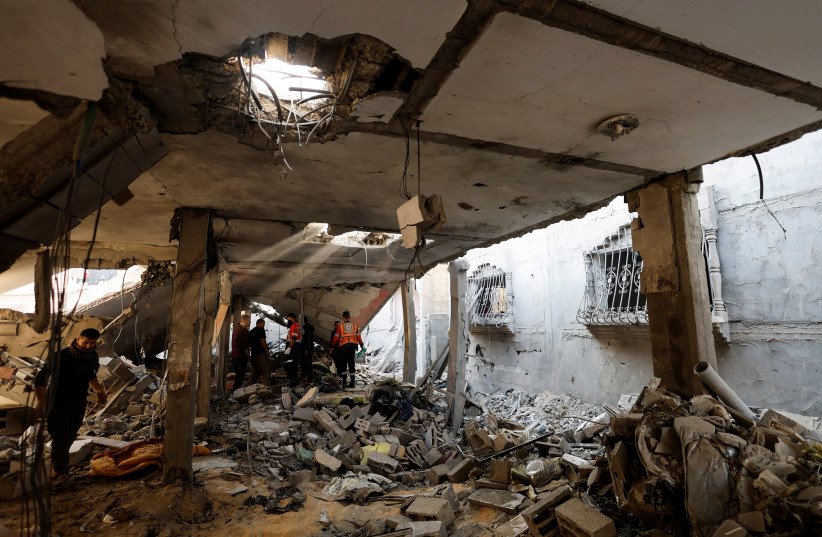The IDF has penetrated to the heart of Khan Yunis, the command center of Hamas in southern Gaza, on multiple fronts simultaneously, achieving this objective on Sunday, through a variety of maneuvers, and announcing it on Monday.
A massive force of multiple brigades, including from Division 162, were thrown into the onslaught with air cover and ground forces to eliminate Hamas command and control capabilities.
IDF sent large force into Shejaia at the same time as Khan Yunis attack
At the same time, the IDF sent a large and hard-hitting force, including Divisions 162 and 36, into Shejaia, known as Hamas’s greatest remaining stronghold in northern Gaza.
A senior IDF official said that the IDF had waited to assassinate the head of Hamas’s Shejaia battalion until just before it was ready to invade in force to maximize the impact of the shock and disorganization on the Shejaia Hamas forces.
In Shejaia, the IDF hurled large infantry forces at Hamas along with massive air strikes and also succeeded in destroying significant positions and command centers.


In addition, the IDF also attacked parts of Jabalya and Beit Hanun in northern Gaza which had not been entirely cleared, though those areas were already more under IDF control than Shejaia, which the IDF only started to attack recently.
The IDF also ramped up its attacks on Hamas in central Gaza, which began recently.
Several hundred Hamas terrorists were killed on Sunday, marking one of the deadliest days for Hamas forces, and bringing the number of its dead to around 6,000 with thousands more wounded.
Hamas is now estimated to maintain around 20,000 remaining potential fighters from its original 30,000.The IDF has said less about the estimated 10,000 Islamic Jihad forces, though there though there have been accounts of attacks against this terror group as well.
Based on the combined attacks, IDF Southern Command Chief Maj.-Gen. Yaron Finkleman said, “we are in the heart of Jabalya, the heart of Shejaia, and as of last night, the heart of Khan Younis. We are in the most intense day since the start of the invasion – in terms of the number of killed terrorists, the number of battles, and the volume of fire brought to bear by ground and air forces. We intend to continue to attack and to deepen our achievements.”
Civilians from Khan Yunis had been directed to evacuate further south to Rafah as well as to a safe area west of Khan Yunis.
IDF closing in on Yahya Sinwar
IDF Chief-of-staff Lt.-Gen. Herzi Halevi on Tuesday hinted that by penetrating to the center of Khan Yunis the IDF is closing in on Hamas chief Yahya Sinwar.
He said that the IDF has encircled southern Gaza and Khan Yunis, where multiple top officials have said Sinwar is hiding, though there is still no precise timeline for capturing or killing him.
“We are attacking the center of gravity” of Hamas and “we are asked frequently about the destruction in Gaza. Hamas is the address. Sinwar is the address.”
Halevi added that Hamas has systematically abused civilian locations for terrorism, and yet the IDF is still trying hard to mitigate any harm to civilians. “Whoever thought that the IDF would not know how to renew the war was mistaken, and Hamas is feeling that a lot.”
The IDF chief flagged that a large number of senior Hamas officials have been killed in recent days, beyond the dozen or so Hamas battalion commanders killed during two months of war.
Also, Halevi said that Hezbollah is trying to hide how badly the IDF attacks on it have damaged its forces.Meanwhile, the IDF has been planning to pump seawater into the Hamas tunnel network in Gaza for weeks, The Wall Street Journal has recently reported and The Jerusalem Post was told weeks ago.
Five large pumps were assembled north of the Shati refugee camp last month, each one capable of pumping thousands of cubic meters of seawater into the tunnels.
The Post had been told by top defense officials that this was one of many ploys the IDF hoped to utilize to destroy Hamas’s vast tunnel network, but due to the structure of the tunnels, it is unclear how useful flooding the tunnels will be.
Israel informed US officials that they were considering this option last month and needed to weigh its feasibility and environmental factors against military necessity.
Some US officials expressed concern about the plan while others supported it.
The process could take weeks and therefore could allow Hamas fighters to evacuate, potentially taking the hostages with them. However, it isn’t clear whether Israel would procrastinate until all estimated 137 remaining hostages are returned.
Environmental concerns
One other major concern is the environmental impact of pumping seawater into the ground. Seawater seeping into the soil can poison already semi-salinated aquifers deep in the ground and seriously destabilize the surface.
Salinated soil would make it extremely difficult to grow crops. There are also concerns that substances stored in the tunnels could seep into the soil further contaminating the area.
Former US officials told The Wall Street Journal that the plan would perhaps bring global condemnation, but they conceded it might be one of the few ways to permanently disable the tunnels.
Egypt flooded Hamas tunnels with seawater in 2015, which led to complaints from farmers in Rafah that it had damaged their crops.
Militaries typically use dogs and robots to clear tunnels. However, the effectiveness of flooding the tunnels may prove too lucrative an option for the IDF, saving them time, money, and manpower.
Reuters contributed to this report.